
Like the foul-mouthed meme based on an iconic Disney character, the Toronto Maple Leafs bleeping did it again. After another year and another playoff disasterclass, in the coming days, weeks, and months, we’ll witness the annual post-mortem: fingers pointed at Mitch Marner for his lofty contract demands, Auston Matthews for his underperformance, and perhaps even president Brendan Shanahan and the front office. But one group will likely escape scrutiny yet again: the fans.
Yes, there are many culprits behind the team’s NHL-record 57-year Stanley Cup drought. But equally to blame—if not more so—are the fans, who duly accept and, in some twisted way, even romanticize the mediocrity of the Maple Leafs. This isn’t a “Core Four” problem. It predates Matthews, Marner, John Tavares, and William Nylander by decades. Since the team’s last Stanley Cup win in 1967, even excluding the decades lost under Bill Ballard’s ownership, the Maple Leafs have never truly iced a powerhouse that screamed “championship contender.”
Take the Muskoka Five era. Despite Mats Sundin’s regular season consistency, the team’s plucky attitude, and their heartfelt (if misguided) belief that they were “better than they were,” that group was never seen as a true contender. In fact, their only Eastern Conference Final appearance during that stretch came with Sundin on injured reserve and wily veterans like Gary Roberts leading the charge. Yet, the organization stuck with the core—Sundin, Darcy Tucker, Tomas Kaberle, and others—well beyond their expiry date, only cleaning house after the 2007-08 season.
Now in the Brendan Shanahan era, the Core Four have brought the Maple Leafs back to some relevance, but the results are eerily reminiscent of the Sundin years: playoff appearances with no serious threat to go the distance. With another early exit and the potential breakup of the Core Four this offseason, we must ask: How does this keep happening?
To the astute but unpartisan eye, the answer lies in a culture of unaccountability that breeds mediocrity. It’s not just a front office issue—Toronto’s hockey culture is allergic to accountability. And the fans? They’ve helped build a business model that thrives on mediocrity. Or, I’ll reframe the question: What pressure is on the Maple Leafs to win?
Toronto is owned by Maple Leafs Sports and Entertainment (MLSE), a holding company owned by Canada’s two largest telecommunications companies, the provincial municipal workers’ public pension fund and a local construction magnate, and despite the on-ice embarrassment, MLSE has never been in better shape.
Professional hockey in Toronto doesn’t have to compete with other, more prominent North American sports––like football or basketball––the way US franchises must. Not that it would matter much, given that MLSE owns all major sports franchises in Toronto, aside from the Blue Jays.
The holding’s crown jewel, the Maple Leafs, is the most valuable hockey franchise in the world, valued at approximately $4 billion. Last year, the team pulled in close to $310 million in revenue. The club’s media rights are split between Canada’s two largest telecom companies, which coincidentally are MLSE’s two largest shareholders.
But perhaps above all else, the Maple Leafs––like the Dallas Cowboys or New York Yankees––is a brand. Scratch that, when it comes to hockey, it is the brand, and that iconic and impenetrable brand has been built and sustained by the fans.
No matter how many shinny-like plays Marner makes in a deciding game, or how many ill-conceived rosters are assembled by the latest “next-gen” general manager, MLSE knows it can count on Leafs Nation. Bay Street will snap up the outrageously priced lower bowl seats before training camp starts. Suburban fans from Lakeshore, Mississauga Road and King City will scoop up the rest. Even working-class fans will fork over their discretionary income just to see the Buds once in-person.
Jerseys will sell. TV packages will be bought. Maple Leafs Square will be packed with blue-and-white faithful giving the franchise picture-perfect optics on playoff nights, even as the team collapses on the ice. But the organization and MLSE know they don’t have to do a darn thing because they know the fans won’t walk away, and Leafs Nation knows it.
The outbursts and condemnation on X, paper bags over the head, and the occasional jersey burnings are all surface-level. In fact, it’s performative self-flagellation, the kind that signifies tribe-like belonging or something used by professionals to drive engagement. But deep down, they’re not going anywhere.
I know this because I was once one of those fans. My relationship with the Maple Leafs ended the night my immigrant father spent his last dollars to take me to a game at the then-Air Canada Centre, only to see Toronto get humiliated by the Ottawa Senators, 7-1. I was 12. It was the night I turned my back on the franchise and never looked back.
Until more of Leafs Nation finds new hobbies and better ways to spend their hard-earned dollars, nothing will change. The fans will look for scapegoats, but be back in time for early October to reset the Maple Leafs’ life cycle of misery. A famous physicist once said the definition of insanity is doing the same thing over and over and expecting different results. Maybe one day, Leafs Nation will take a collective mental health break. But like the team’s playoff hopes, I’m not holding my breath.
More must-reads:
- Maple Leafs HC paints ominous picture for Nick Robertson despite new deal
- Maple Leafs' pursuit of Jack Roslovic puts one player on chopping block
- The '200-passing yards in first 20 NFL games' quiz
Breaking News
Trending News
Customize Your Newsletter
 +
+
Get the latest news and rumors, customized to your favorite sports and teams. Emailed daily. Always free!








